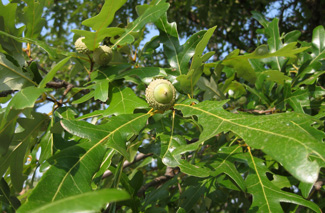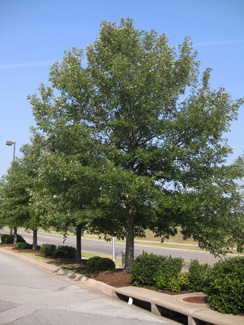Resource Library
Plant of the Week: Overcup Oak
The University of Arkansas System Division of Agriculture does not promote, support or recommend plants featured in "Plant of the Week." Please consult your local Extension office for plants suitable for your region.
Overcup Oak
Latin: Quercus lyrata
|
|
| Overcup acorns are among the easiest to identify because the cap almost completely enclosed the seed. (Image courtesy Gerald Klingaman) |
|
|
| These 15-year-old overcup oaks are showing the rounded-pyramidal form of young trees. (Image courtesy Gerald Klingaman) |
I learned a new tree last week. The overcup oak (Quercus lyrata) is a tree I had heard of and been intrigued by during all the years I spent driving I-40 from Fayetteville to Little Rock. About half way through the journey I saw the sign pointing north to Lake Overcup in Conway County. Regrettably, I never took the trip to meet the tree in the wild, instead I came across it in a parking lot.
Overcup oak is a medium-sized, short-trunked oak growing about 60 feet tall and wide with a crown that resembles a symmetrical three-quarters globe of branches. The overcup oak is a member of the white oak group and has a gray-brownish trunk similar to that of white oak. Its many branches arise at right angles from the trunk and provide both strong limb support and a predictable, symmetrical form. As a white oak relative, 300-year-old trees are not unusual.
Overcup oak leaves are thick-textured, 6 to 8 inches long and to 3 inches wide with an irregular outline. The epitaph “lyrata” is reference to the fact that the largest lobes are often squarish in outline and resemble the stringed musical instrument favored by the Ancient Greeks. The upper leaf surface is a rich green with the underside whitish pubescence. Fall color is usually yellow orange to brownish.
The inch long, egg-shaped acorn is the easiest way to identify the species because it is almost completely encircled by the cup. Being a member of the white oak tribe the acorn matures in one growing season. Those wishing to grow trees from seed must plant the acorns immediately in the fall and never allow it to dry out. The radicle, or root tip, will emerge in the fall and become established but the shoot tip will not begin to grow until the acorn has undergone at least two months of chilling temperatures.
The overcup oak is native to the coastal states from Virginia to Texas, extending inland along waterways as far north as Tennessee and Arkansas where it occurs throughout the Delta region and lower parts of the state. It is not found native on the Ozark Plateau or in the Ouachita Mountains. In its native range it is a bottomland associate where it is often found with willow oak, water oak and other tree species adapted to wintertime flooding.
This species is a newcomer to the landscape trade, being only touted as a landscape tree during the last couple decades. Several factors make it well suited for landscape use. First, it is perhaps the most uniform oak when grown from seed, with trees having almost a clonal-like look from youth through old age. Secondly, being a bottomland species it is adapted to poorly aerated, often compacted soils so it does well in the built landscape where all kinds of bad things happen to the native soil during construction. Lastly, the overcup oak is a medium-sized oak, making it better suited to landscape locations where a 50-foot tree is easier to accommodate than giants such as willow oak.
Overcup oak is an ideal tree for use in landscapes such as parks and golf courses where there are few constraints on available space. In the home landscape it can be used as a shade tree, but remember it will grow as wide as it is tall, so provide a radius of 25 feet for the crown to expand over time. Though it is a bottomland species it survives without pampering once it has become firmly established in the landscape.
By: Gerald Klingaman, retired
Retired Extension Horticulturist - Ornamentals
Extension News - September 20, 2013
The University of Arkansas System Division of Agriculture does not maintain lists of retail outlets where these plants can be purchased. Please check your local nursery or other retail outlets to ask about the availability of these plants for your growing area.
***END OF OU MIGRATED CONTENT***
Overcup Oak
Milk and dairy beef sales total $100 million per year from approximately 420 dairy herds with 40,000 head of milk cows. The Extension Service provides research-based information to producers and industry personnel to help them be more competitive in an increasingly competitive market.
Environmental regulations and the ability to comply with them is a primary concern of producers. Waste management is emphasized in dairy Extension programs.
Since Arkansas and neighboring states normally rank in the bottom few states in the U.S. for production per cow, emphasis is also placed on improving efficiency of production. Forage quality and usage, improved herd management, financial record-keeping (including Dairy Herd Improvement Association records), ration-balancing, and cow comfort, including heat-stress management, are a few subjects addressed by Extension. Sire selection and reproduction are also stressed because the genetic levels of the herd and overall fertility have marked effects on net profit of the herd.
The state of the U.S. and international dairy industry may see changes that are even more dramatic in the future. The ongoing reorganization of federal milk marketing orders and shifts in milk production areas within the U.S. make Extension educational efforts even more critical to improving efficiency of milk production for both dairy producers and consumers.

